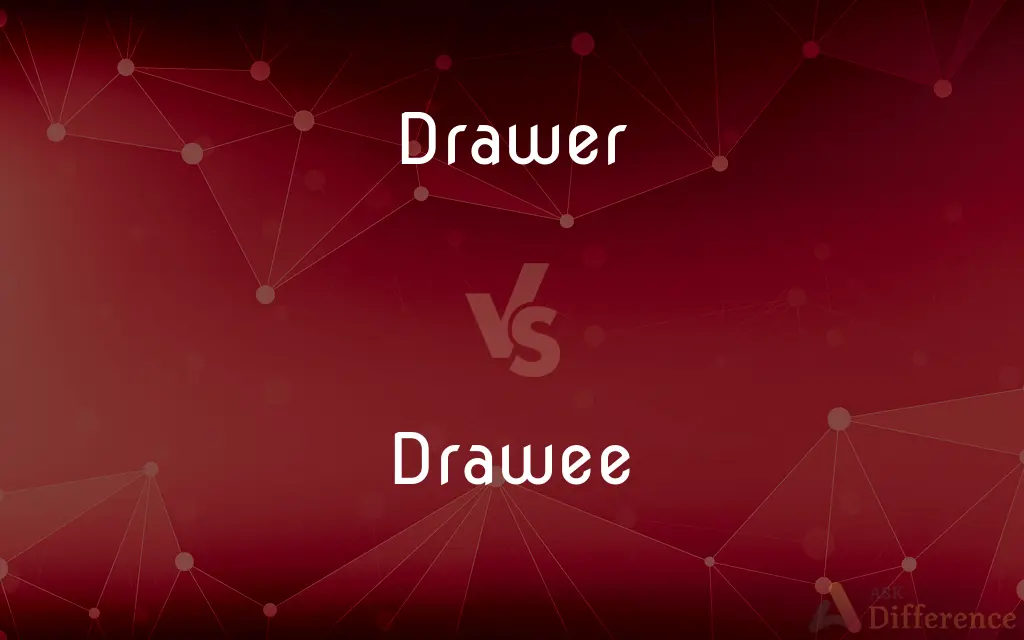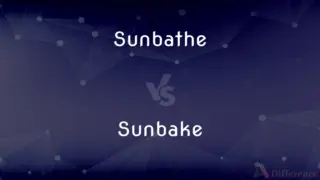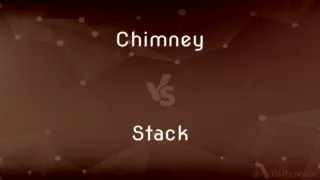Drawer vs. Drawee — What's the Difference?
By Maham Liaqat & Fiza Rafique — Updated on June 12, 2024
Drawer refers to the entity that writes a check or draft, instructing a payment, while Drawee is the bank or party directed to pay the amount specified. Both play crucial roles in financial transactions.

Difference Between Drawer and Drawee
Table of Contents
ADVERTISEMENT
Key Differences
The term "Drawer" specifically denotes the party in a transaction that initiates a draft, check, or bill of exchange, essentially instructing another party to pay a specified amount to a third party. Conversely, the "Drawee" is the party, typically a bank or financial institution, that is directed by the drawer's document to pay the specified amount.
The action of drawer is foundational in banking and financial operations, where the drawer's role is to authorize the transfer of funds from their account. The drawee holds the funds and is responsible for fulfilling the payment instruction as per the drawer's request, making them a critical link in the chain of payment.
The drawer is the originator, crafting the request for payment. This contrasts with the drawee, who receives this request and must then act on it, highlighting a clear division of roles within financial exchanges.
The relationship between drawer and drawee is symbiotic yet distinct. While the drawer has the authority to issue payment orders, the drawee possesses the actual resources to fulfill these orders. This balance ensures the smooth execution of financial transactions.
The legal obligations of the drawer include ensuring sufficient funds are available for the drawee to complete the transaction. Failure to do so can result in financial penalties and legal repercussions, underscoring the responsibility that comes with being the drawer.
ADVERTISEMENT
Comparison Chart
Definition
Party that writes and issues a draft
Party, usually a bank, asked to pay
Role in Payment
Initiates the payment request
Executes the payment upon request
Legal Obligation
Ensure sufficient funds are available
Verify authenticity and pay as directed
Relationship
With the payee to transfer funds
With the drawer to fulfill payment
Example
Writes a check
Bank that cashes the check
Compare with Definitions
Drawer
Individual requesting payment through a draft.
The drawer instructed his bank to pay the invoice amount.
Drawee
Party responsible for paying a promissory note.
The drawee agreed to the terms of the promissory note.
Drawer
The creator of a bill of exchange.
The company's accountant, acting as the drawer, issued a bill to the supplier.
Drawee
The bank where a check is cashed.
The local bank, as the drawee, processed the check.
Drawer
Initiator of a bank draft.
As the drawer, she requested a bank draft for the down payment.
Drawee
The receiver of a payment order from the drawer.
As the drawee, the bank ensured the payment was made.
Drawer
Party making a promissory note.
The business owner, the drawer, signed a promissory note to the lender.
Drawee
Financial institution fulfilling a draft.
The drawee bank debited her account for the draft amount.
Drawer
A person who writes a check.
John, the drawer, wrote a check for $500.
Drawee
The entity directed to pay a bill of exchange.
The drawee, upon receiving the bill, paid the specified amount.
Drawer
One that draws, especially one that draws an order for the payment of money.
Drawer
(banking) One who writes a bank draft, check/cheque, or promissory note.
Drawer
The person who writes a check or draft instructing the drawee to pay someone else
Common Curiosities
Can a drawer and drawee be the same person?
In some cases, especially in promissory notes, the drawer and drawee can be the same person, but in traditional banking transactions involving checks, they are distinct parties.
What is a drawer in banking?
A drawer in banking is the person or entity that writes and signs a check or draft, instructing a bank or financial institution to pay a specified amount to a third party.
Can a drawer stop a payment?
Yes, a drawer can issue a stop payment order to the drawee, requesting not to proceed with the transaction for reasons such as theft, loss, or dispute over the payment.
What legal obligations does the drawer have?
The drawer is legally obligated to ensure there are sufficient funds available in their account for the drawee to complete the transaction.
What role does the payee play in this relationship?
The payee is the party that receives the payment from the drawee, as instructed by the drawer, completing the transaction cycle.
Is a signature necessary for both drawer and drawee?
A signature is necessary from the drawer to validate the check or draft, while the drawee's action of paying does not require a signature but verification of the drawer's signature and account status.
How does the drawee verify a transaction?
The drawee verifies a transaction by checking the drawer's account for sufficient funds, the authenticity of the signature, and the legality of the payment order.
What is a bill of exchange?
A bill of exchange is a written order by the drawer that binds the drawee to pay a certain amount to the payee or their order on a specified date.
Can the drawee be a party other than a bank?
In certain types of transactions, such as those involving a bill of exchange, the drawee can be an individual or entity other than a bank.
Who is considered the drawee?
The drawee is typically a bank or financial institution that is directed by the drawer's document (like a check or draft) to pay a specified amount to a third party.
What happens if the drawee refuses to pay?
If the drawee refuses to pay, it may be due to reasons such as insufficient funds, a stop payment request by the drawer, or issues with the check's validity. The drawer may face penalties or legal action.
How are disputes between drawer and drawee resolved?
Disputes are typically resolved through legal channels, banking regulations, or negotiation, depending on the nature of the disagreement.
What documentation is required for drawer and drawee transactions?
Typically, a written document like a check, draft, or bill of exchange is required, containing the payment amount, date, payee's name, and the drawer's signature.
Does the drawer need to notify the drawee before writing a check?
No, the drawer does not need to notify the drawee before writing a check, but it is their responsibility to ensure there are enough funds available.
What are the consequences for a drawer if a check bounces?
If a check bounces due to insufficient funds, the drawer may face bank fees, penalties, and potential legal action for issuing a bad check.
Share Your Discovery

Previous Comparison
Sunbathe vs. Sunbake
Next Comparison
Chimney vs. StackAuthor Spotlight
Written by
Maham LiaqatCo-written by
Fiza RafiqueFiza Rafique is a skilled content writer at AskDifference.com, where she meticulously refines and enhances written pieces. Drawing from her vast editorial expertise, Fiza ensures clarity, accuracy, and precision in every article. Passionate about language, she continually seeks to elevate the quality of content for readers worldwide.
















































